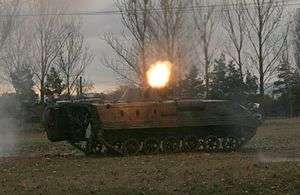MLVM
| MLVM | |
|---|---|
|
MLVM firing during a demonstration | |
| Type | Armoured personnel carrier |
| Place of origin |
|
| Service history | |
| In service | late 1980s - present |
| Used by | Romanian Land Forces |
| Production history | |
| Manufacturer |
Uzina Mecanică Mizil (first 40 vehicles) Uzina Tractorul Brașov (the rest of the vehicles) |
| Specifications | |
| Weight | 9 tonnes |
| Length | 5.85 m (19 ft 2 in) |
| Width | 2.71 m (8 ft 11 in) |
| Height | 1.95 m (6 ft 5 in) |
| Crew | 2 (driver and gunner) |
| Passengers | 7 |
|
| |
| Armor | protection against 7,62 mm rounds |
Main armament |
1 × 14.5 mm KPVT machinegun 600 rounds |
Secondary armament |
1 × 7.62 mm PKT machinegun 2500 rounds |
| Engine |
Saviem 798-05M2, supercharged diesel, 4-stroke, 154 hp |
| Transmission | manual |
| Suspension | Torsion bar |
| Fuel capacity | 480 litres (internal: 360 l and doors: 120 l) |
Operational range | 700 km (430 mi) |
| Speed |
48 km/h (30 mph) 15 km/h (9.3 mph) in water |
MLVM (Romanian: Mașina de Luptă a Vânătorilor de Munte, meaning "infantry fighting vehicle of vânători de munte") is a Romanian armoured personnel carrier. The vehicle was designed and used as an infantry fighting vehicle for the vânători de munte units of the Romanian Army, though technically it is a tracked armoured personnel carrier according to UN classification because of its light armour and armament. Armored vehicle is based on the chassis of the Soviet SU-76 manufactured during World War II.
Description
MLVM is a specialized vehicle designed breasted mountain. The case is similar to the Soviet fighting machine of the BMP-1 infantry, but is substantially amended. The turret is fitted on the MINISTER and the IFV TAB-71. The vehicle has been designed specifically to be used in mountainous areas of the country.
Armament consists of a heavy machine gun KPVT 14.5 mm caliber, and a bow machine gun PKT, caliber 7.62 mm Armament equipment does not have a system of stabilization. Because of limited firepower, the MINISTER cannot be classified as a combat infantry. The Group mountain has in endowment and an anti-tank grenade launcher AG-7. The envelope is made of welded steel plates and ensures protection against bullet caliber 7.62 mm schijelor artillery. The suspension is a torsion bar. Galeții (six from each drive sprocket) are găuriți to reduce weight. MINISTER is fully amphibious, being propelled with a maximum speed of 5–6 km/h in water through the hopper. Prior to the crossing of rivers or lakes (although the MINISTER is not amphibious, designed for desantul), high breakers should be plate waves.
The internal arrangement is similar to the model of the Soviet BMP-1. In front, on the left, stands the driver's hatch. It has at its disposal three periscopes for observation during the day. Optionally, a system can be mounted on at night. Behind the driver's hatch is located the Commander. Both have above in the ceiling, a shutter. The vehicle Commander has at its disposal three periscopes for observation of the field of battle. One of these can be raised to explore distant targets at sea. The Commander shall have a system of night vision (infrared). Fixed upon, which became the Group's Commander vânători de munte, sits in the middle of the vehicle, in the turret. In room desantului three soldiers stand on either side. They have at their disposal a periscope sight day which may execute the drawdown by ambrazurile from the sides of the vehicle. At the rear is a door that can be used as a reservoir. The door has two ambrazuri and two periscopes in order for hunting to be able to run mountain fire in the rear of the vehicle.
Modernization
A similar modernization package model MLI-84 m has been proposed and for the MINISTER. It included the OWS 25R turret (Oerlikon KBA automatic Cannon-07 25 mm caliber coaxial machine gun PKT and can equip with a guided anti-tank missile launcher Spike), the illumination of the warning system, smoke grenade launchers, more advanced optical system, automatic transmission, Mercedes-Benz diesel engine or Deutz (approximately 400 horsepower), automatic fire extinguishing systems, and improved command and control and the ability to mount additional armour plates. The weight of the new vehicle was 11.3 tons, but the maximum speed, power and autonomy were bigger. As a result of improvements in weaponry, the vehicle can be classified as a combat infantry.
The result of the modernization programme was a vehicle that is compatible with NATO standards. A prototype was shown at the exhibition of arms and military technical Expomil 2005.
Variants
- MLVM AR-Version fitted with a 1982 bomb Launcher Model 120 mm caliber, installed in the living room of desant. During firing the two shutters are opened in the side. It can be removed from the vehicle.
- MLVM ABAL-vehicle intended for the transport of ammunition (2.1 tons). The turret is missing, and the armament consists of a machine gun PKT fastened near the shutter master. Standard: NBC protection, firefighting and communications equipment.
- MLVM MEDEVAC-medical evacuation Vehicle and the granting of first aid. Superstructure and armament are similar version ABAL.
References
| Wikimedia Commons has media related to MLVM. |
- Cristopher F. Foss, Jane's Armour and artillery 1997-98, ISBN 0-7106-1542-6
